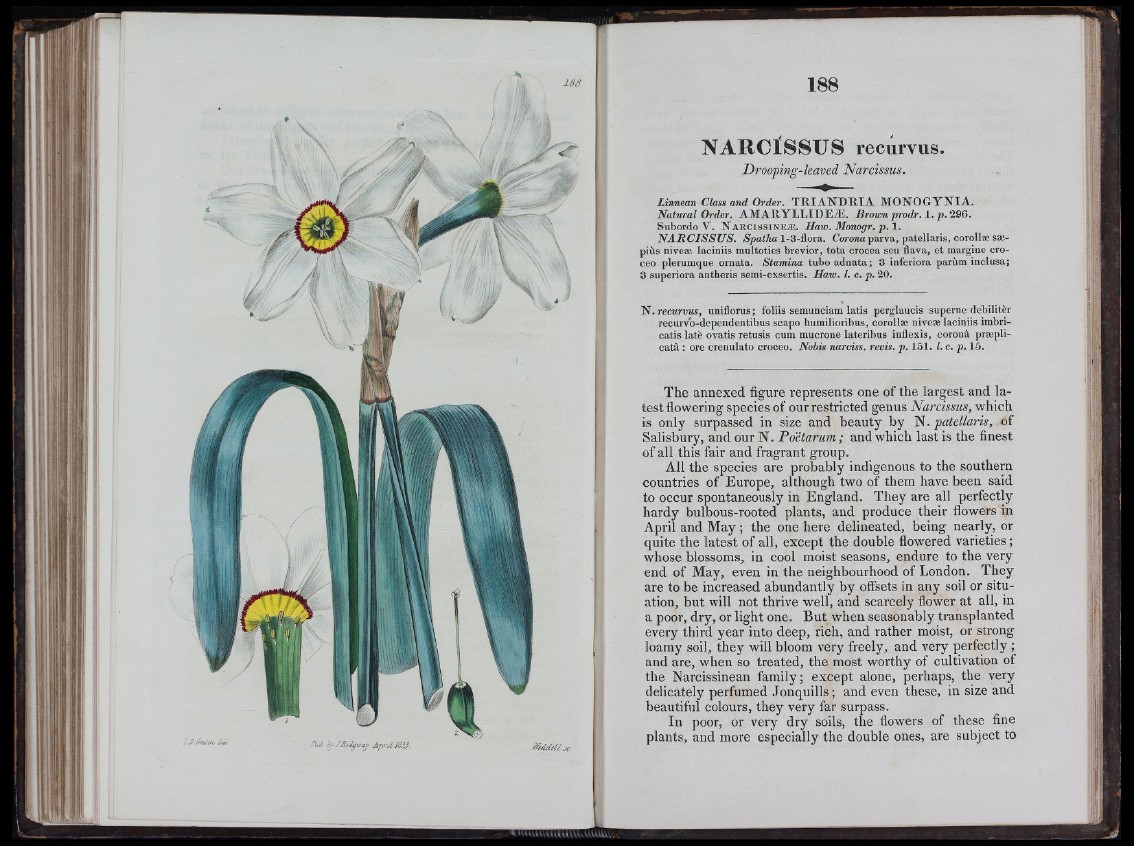
188 188
NARCISSUS recurvus.
Drooping-leaved Narcissus.
Linnean Class and Order. T R IA N D R IA M O N O G Y N IA .
N a tu ra lO rd e r. A M A R Y L L ID EÆ . Brown p rodr. I. p . 296.
Subordo V . N a r c i s s in e æ . Haw. Monogr. p . \ .
N A R C L S SU S . Spatha l-3-üora. Cojma parva, patellaris, corollæ sæpiùs
niveæ laciniis multoties brevior, tota crocea seu flava, et margine croceo
plerumque ornata. Stamina tubo adnata; 3 inferiora parùm inclusa;
3 superiora antheris semi-exsertis. Haw. I. c. p . 20.
»
N . recurvus, iiniflorus ; foliis semunciam latis perglaucis superne debilitèr
recurvb-dependentibus scapo humilioribus, corollæ niveæ laciniis imbricatis
latè ovatis retusis cum mucrone lateribus inflexis, coronà præpli-
catâ : ore crenulato croceo. Nobis narciss, revis. p . 151. l. c. p. 15.
- FJBUNì- iti- full hyJRiiyway Aj-ls-iI 1S33■
The annexed figure represents one of the largest and latest
flowering species of our restricted genus Narcissus, which
is only surpassed in size and beauty by N. patellaris, of
Salisbury, and our N. Poetarum; and which last is the finest
of all this fair and fragrant group.
All the species are probably indigenous to the southern
countries of Europe, although two of them have been said
to occur spontaneously in England. They are all perfectly
hardy bulbous-rooted plants, and produce their flowers in
April and May; the one here delineated, being nearly, or
quite the latest of all, except the double flowered varieties;
whose blossoms, in cool moist seasons, endure to the very
end of May, even in the neighbourhood of London. They
are to be increased abundantly by offsets in any soil or situation,
but will not thrive well, and scarcely flower at all, in
a poor, dry, or light one. But when seasonably transplanted
every third year into deep, rich, and rather moist, or strong-
loamy soil, they will bloom very freely, and very perfectly;
and are, when so treated, the most worthy of cultivation of
the Narcissinean family; except alone, perhaps, the very
delicately perfumed Jonquills; and even these, in size and
beautiful colours, they very far surpass.
In poor, or very dry soils, the flowers of these fine
plants, and more especially the double ones, are subject to